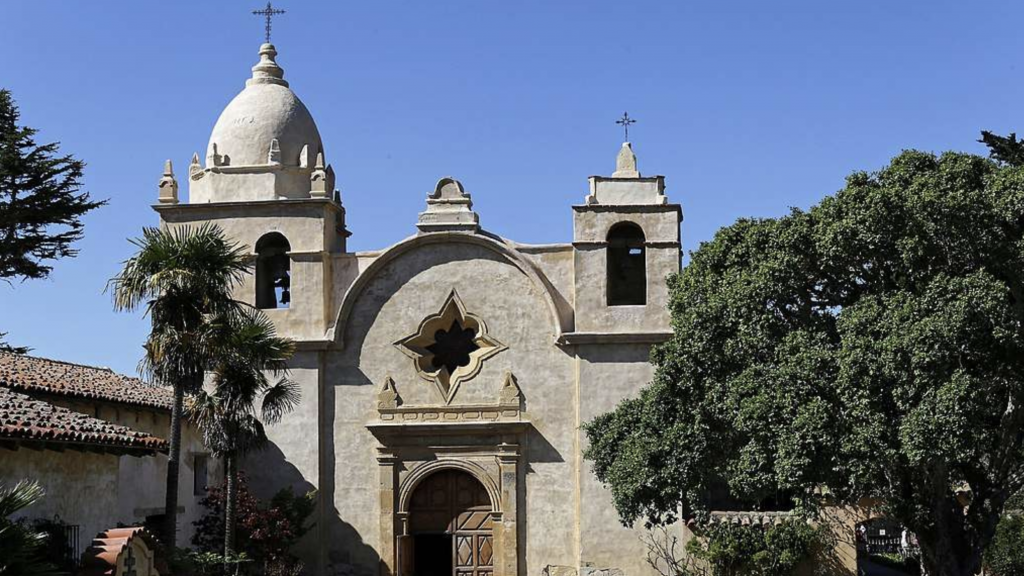A Catholic group has received a large grant to restore one of the oldest California missions and to provide a place for tourists to examine the state’s religious and cultural history.
In February, Carmel Mission Foundation received a $1,800,000 grant for the Downie Museum and Basilica Forecourt Restoration, which seeks to rejuvenate the Mission San Carlos Borromeo de Carmelo located in Carmel, Calif., about five miles south of Monterey.
The project is scheduled to be completed by the fall in time to commemorate the 250th anniversary of the mission’s establishment. The grant was issued by the Hind Foundation, which provides non-profit organizations with the resources and tools to help restore monumental structures.
Linda Gardner, office manager for the Carmel Mission Foundation, emphasized the mission’s historical significance and value to the community.
“The Carmel Mission Basilica and Museums draw over 300,000 visitors annually, of all ages, races, ethnicity, genders, and religious backgrounds. As the burial place of one of America’s founding fathers, Saint Junipero Serra, Carmel Mission is a place of significant national and international historical importance for both religious and secular alike,” she told CNA.
The grant will be used to update according to state regulations, reinforce deteriorating structures, and restore the 100-year-old adobe museum and the main courtyard entrance of the Carmel Mission.
In the museum, the project will install new electrical, lighting, and fire suppression. It will also augment the museum’s masonry, which needs to be seismically strengthened in accordance with state law to protect the structure from earthquakes.
The main visitor restrooms will be relocated and removed from the original structure, restoring the adobe’s original floor plan. The museum’s exhibit space will then be doubled.
For the museum and the outside courtyards, ADA access regulations will be updated to grant people with disabilities access to the entire mission, including the garden. The restoration project will also revise the outside drainage system.
“The disabled and elderly will benefit greatly from these accessibility improvements by providing step-free paths and hazard-free access throughout the garden, basilica, museums, exhibits, restrooms, and cemetery allowing all to revel in its glory,” Gardner said.
“The grading of the Forecourt will not only provide ADA access, but will also remedy current flooding and drainage issues that are severely affecting the foundation of the renowned Basilica, Baptistery, and Bell Tower.”
Gardner said Downie Museum adobe represents a rich religious and cultural history of California. She said the museum's structure was established in 1921 as guest quarters for visiting priests. It was then dedicated as a museum in 1980 in honor of Sir Harry Downie, who spent 50 years helping restore the Mission.
“The Downie Museum exhibits are an important tool used to educate about the region’s history, the founding of the missions, and the formation of our 31st state, California. The museum currently offers visitors a 15-minute video on the overview of the Carmel Mission and displays feature artifacts and items dating back to the 1700s used by early mission inhabitants and recovered on the property during the mission's first restoration period from 1919-1940s.”
The Carmel Mission, established in 1773, was the second of the nine missions founded by Saint Junipero Serra. Gardner said the 249-year-old property is home to some of California’s oldest structures, art, and artifacts - some of which date back to 1568.
This building served as Serra’s living quarters and headquarters for the California mission system. It was later used to house the mission’s physicians until it was abandoned during the 1830s.
The current walls are adobe, meaning they are made from sun-dried clay. The structure’s roof is built out of wooden poles covered with two-piece clay tiles. A stone fireplace built by Carmel sculptor Jo Mora is featured inside the mission.
“The Downie Museum is an important cultural resource with tangible ties to the past and by preserving these historical areas, we ensure that future generations will have access to the extraordinary artifacts, art, literature, architecture, and history of everyday life recording the progress from the first peoples of California to the present day,” Gardner said.
As the pandemic continues to affect local businesses and livelihoods, Gardner expressed hope that the repairs will also help recover the region‘s tourist-driven economy which has suffered due to the pandemic restrictions and business closures.
She said the new plans for the community offer open spaces for social distancing requirements. She expressed hope that, when appropriate, the rejuvenated structure will allow for a celebration of the mission’s 250th anniversary, and “support efforts with the Covid-19 recovery plan for Monterey County.”
“As we look towards the recovery plan for our community, and ways to stimulate our tourist-driven local economy adversely affected by the COVID -19 pandemic, we strive to support our community partners, small businesses, hotels, and destination management firms to help them engage travel, and when appropriate, drive tourism back to our region’s hotels, museums, restaurants, and shops,” she said.

